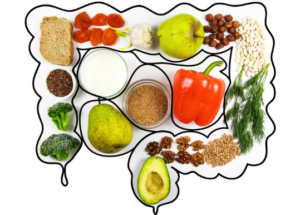
Everyone has gas in the digestive tract, but people often believe normal passage of gas to be excessive. Most foods that contain carbohydrates such as fiber, starches and sugars have essential nutrients that your body turns into glucose to give you the energy to function. By contrast, these same food nutrients may be causing your body to produce more gas.
Before making any dietary modifications to your diet, we always recommend speaking with a Registered GI Dietitian to make sure you are still receiving the necessary nutrients for your body. You can check out IFFGD’s Dietitian Listing by clicking the button below.
Sugars
The sugars that cause gas are raffinose, lactose, fructose, and sorbitol.
- Raffinose — Beans contain large amounts of this complex sugar. Smaller amounts are found in cabbage, Brussels sprouts, broccoli, asparagus, other vegetables, and whole grains.
- Lactose — Lactose is the natural sugar in milk. It is also found in milk products, such as cheese and ice cream, and processed foods, such as bread, cereal, and salad dressing. Many people, particularly those of African, Native American, or Asian background, have low levels of the enzyme lactase needed to digest lactose. Also, as people age, their enzyme levels decrease. As a result, over time people may experience increasing amounts of gas after eating food containing lactose.
- Fructose — Fructose is naturally present in onions, artichokes, pears, and wheat. It is also used as a sweetener in some soft drinks and fruit drinks.
- Sorbitol — Sorbitol is a sugar found naturally in fruits, including apples, pears, peaches, and prunes. It is also used as an artificial sweetener in many dietetic foods and sugarfree candies and gums.
Watch Registered GI Dietitian Emily Haller, talk about sugar
Starchy Foods That Can Cause Gas
Most starches, including potatoes, corn, noodles, and wheat, produce gas as they are broken down in the large intestine. Rice is the only starch that does not cause gas.
Fiber
Dietary fiber is carbohydrate that is indigestible in the small intestine and reaches the colon relatively intact. In the colon, certain bacteria digest fiber (fermentation), which produces gas. Dietary fiber can be classified as either soluble or insoluble.
Soluble fiber dissolves in water and becomes a soft gel. It is found in oat bran, beans, barley, nuts, seeds, lentils, peas, and most fruits. Insoluble fiber does not dissolve or gel in water. It absorbs liquid and adds bulk to stool. Cellulose (found in legumes, seeds, root vegetables, and vegetables in the cabbage family), wheat bran, and corn bran are examples of insoluble fiber.
High fiber substances containing both soluble and insoluble fibers have the properties of both. They include oat bran, psyllium, and soy fiber. Methylcellulose is a semi-synthetic fiber. It is soluble and gel forming, but not fermentable.
Types of fiber differ in the speed and extent to which they are digested in the GI tract, and in the process of fermentation. The solubility and fermentation of a particular fiber affects how it is handled in the GI tract. However, the effect of identical fibers varies from person to person.
A gradual increase in dietary fiber can modify and improve symptoms. But individual responses vary and too much of a type of fiber can worsen symptoms. It may be necessary to try different types of fiber. With any dietary fiber it is best to start low and go slow.
Learn more about Diet, Nutrition, and Digestive Health
Watch Ceciel Rooker, President of IFFGD, discuss the importance of diet and nutrition with Shanti Eswaran.
Adapted from IFFGD Publication #155 compiled by William F. Norton, Publications Editor, International Foundation for Functional Gastrointestinal Disorders, Milwaukee, WI.














